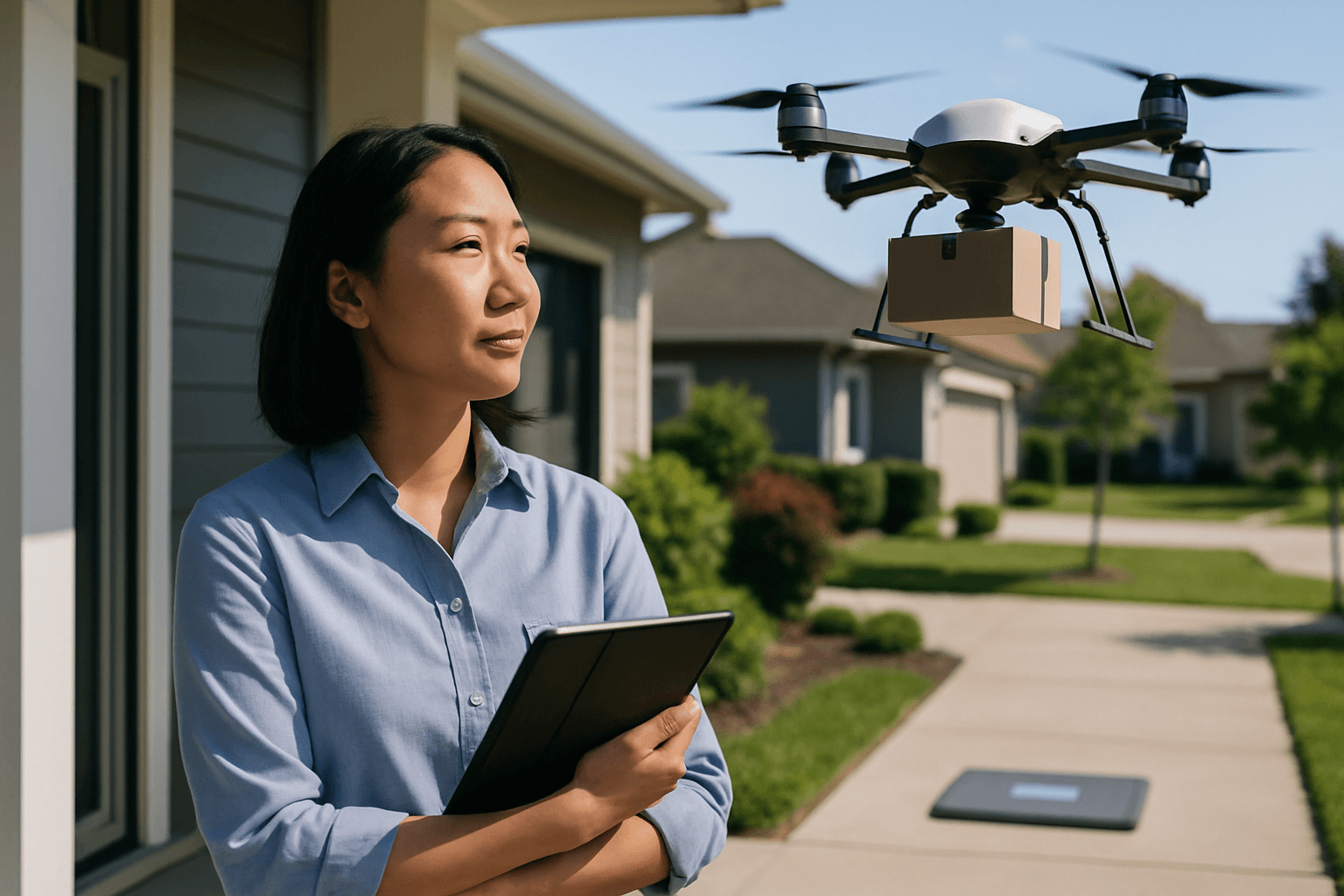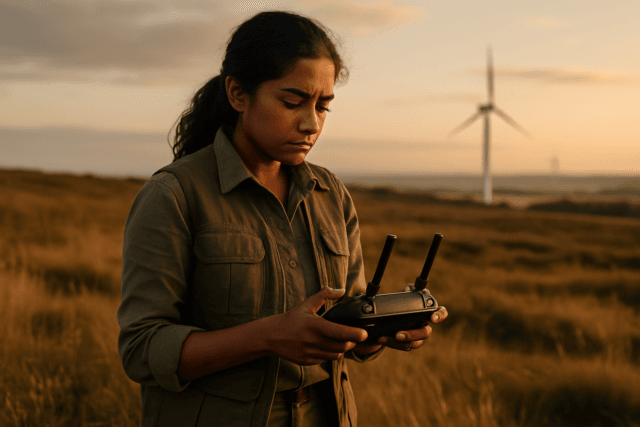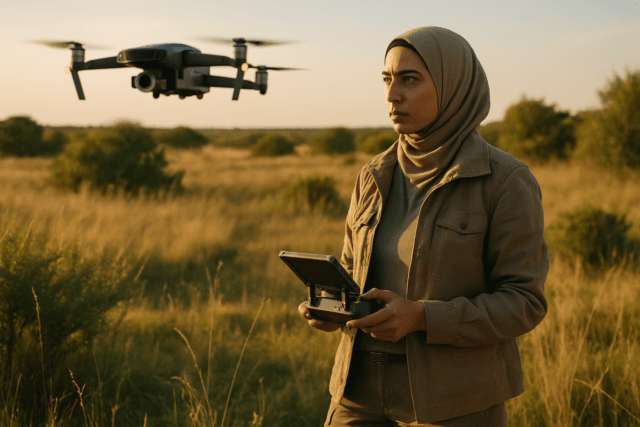Imagine a world where your urgent package arrives not by road, but by air, quietly descending onto your doorstep just minutes after you click “order.” This vision, once confined to science fiction, is rapidly becoming a reality as autonomous delivery drones redefine the landscape of logistics and last-mile delivery. Driven by a confluence of technological breakthroughs, evolving consumer demands, and a push for greater efficiency and sustainability, unmanned aerial vehicles (UAVs) are poised to revolutionize how goods are transported, offering unprecedented speed, accessibility, and environmental benefits.
The global commercial drone market was valued at approximately $8 billion in 2022 and is projected to reach $47 billion by 2030, underscoring the immense growth expected in this sector. Companies like Amazon, Google Wing, and UPS have already transitioned beyond experimental phases, implementing limited commercial operations in various markets. This article delves into the transformative future of autonomous delivery drones, exploring the key trends, technological advancements, regulatory shifts, and challenges that will shape their widespread adoption.
Technological Leaps Powering Drone Delivery
The foundation of the burgeoning autonomous delivery drone industry lies in continuous and rapid technological advancements. These innovations are making drones smarter, safer, and more capable, overcoming previous limitations in battery life, payload, and navigation.
Artificial Intelligence and Machine Learning for Enhanced Autonomy
At the forefront of drone evolution is the integration of Artificial Intelligence (AI) and Machine Learning (ML). These technologies empower drones with advanced capabilities, enabling them to operate autonomously, navigate complex environments, and make intelligent decisions in real-time.
- Real-time Route Optimization and Dynamic Navigation: AI algorithms are crucial for optimizing drone delivery routes, minimizing distance, and reducing overall delivery time. They process vast amounts of real-time data, including weather conditions, traffic patterns, airspace restrictions, and even package size, to determine the most efficient and safest path. This allows drones to adjust their flight paths on-the-fly, ensuring timely deliveries even when conditions change unexpectedly. The continuous learning from historical data further refines route planning, leading to reduced energy consumption and lower operational costs.
- Advanced Obstacle Avoidance and Safety: Equipped with advanced sensors such as cameras, LiDAR, and radar, AI-powered drones possess sophisticated collision avoidance capabilities. These systems can detect obstacles in real-time, ranging from birds and buildings to power lines and trees, and adjust the drone’s flight path accordingly, significantly reducing the risk of accidents. Some systems even provide near-human reflexes for obstacle detection.
- Flight Control and Stability: AI technology enhances drone flight control and stability by monitoring environmental factors like wind speed and atmospheric pressure, allowing the drone to adjust its flight attitude for safe delivery. This ensures reliable operation even in challenging conditions.
Battery Technology and Power Solutions
Historically, limited range and battery life have been significant hurdles for widespread drone delivery. However, breakthroughs in battery technology are addressing these constraints.
- Increased Energy Density and Longevity: Recent innovations in lithium-ion formulations and the emergence of solid-state batteries are leading to greater energy density and longer flight times for drones. This translates to extended operational ranges and the ability to cover longer distances, making drones practical for a wider array of delivery routes, including more remote locations.
- Sustainable Power Sources: The shift towards lightweight materials and improved battery technology not only extends flight range but also reduces charging downtime. The future may also see the integration of alternative energy sources like solar power and hybrid systems to further extend flight capabilities and enhance environmental sustainability. Solar-powered charging stations are being explored to reduce reliance on fossil fuels.
Swarm Technology and Multi-Modal Integration
The efficiency of drone delivery is set to expand beyond single-drone operations with the advent of swarm technology and multi-modal integration.
- Coordinated Drone Swarms: Coordinated fleets of drones, or “drone swarms,” can deliver multiple packages simultaneously, significantly increasing delivery capacity and efficiency. These swarms could also prove invaluable in emergency scenarios, such as disaster relief, where supplies need to be delivered quickly to numerous locations.
- Hybrid Delivery Systems: New systems are emerging that combine airborne drones with ground robots, allowing for package handoffs mid-route. This multi-modal approach enhances efficiency, particularly in dense urban settings where navigating varied terrain and obstacles is crucial. For example, a drone might transport a package to a designated drop-off point, where a smaller ground robot then completes the final leg of delivery to the customer’s door.
Evolving Regulatory Landscape
The rapid technological advancements in autonomous delivery drones necessitate the development of robust and comprehensive regulatory frameworks to ensure safe and scalable operations. Historically, fragmented regulations and the requirement for individual waivers for “Beyond Visual Line of Sight” (BVLOS) operations have hindered widespread adoption.
Standardized BVLOS Operations
A significant trend is the move towards standardized regulations for BVLOS operations, which are flights conducted by drones beyond the direct visual sight of their operators. The U.S. Department of Transportation, through the Federal Aviation Administration (FAA), has proposed a comprehensive rule aimed at standardizing these operations. This framework, potentially codified as Part 108, outlines detailed requirements for flight operations, aircraft standards, separation procedures, cybersecurity, and data-sharing obligations.
- Eliminating Waivers: The new policy aims to eliminate the need for time-consuming individual waivers, creating a more predictable regulatory environment for commercial drone deployment. This is expected to accelerate the adoption of drone deliveries by providing a clear pathway for routine operations.
- Airspace Integration and Traffic Management: Safely integrating drones into national airspace alongside manned aircraft is a primary concern. The proposed FAA rule introduces the role of “Automated Data Service Providers” (ADSPs) to facilitate cooperative traffic deconfliction between UAS and manned aircraft. These entities would provide digital services for maintaining situational awareness and ensuring drones yield to all manned aircraft broadcasting position.
- Altitude and Operational Zones: Regulations typically stipulate that flights must remain at or below 400 feet above ground level (AGL) and originate from pre-designated, access-controlled locations with FAA-approved boundaries. Operators will also require FAA approval for specific flight areas, including estimates of daily operations and safety mitigations.
- International Harmonization: Regulatory bodies globally, such as the European Union Aviation Safety Agency (EASA), are also establishing frameworks for drone services, including parcel delivery in urban areas. This international collaboration is vital for fostering a globally interoperable drone delivery ecosystem.
Addressing Public Concerns and Trust
Beyond technical and regulatory hurdles, public acceptance remains crucial for the widespread adoption of drone delivery services.
- Noise Pollution: One of the main concerns is noise pollution, particularly in residential areas. Route planning can help mitigate this by directing drones over busy roads, and advancements in drone design are focusing on reducing noise through propeller size and positioning.
- Privacy and Safety: Concerns about privacy, especially regarding cameras on drones, and general safety must be adequately addressed. Continuous advancements in collision avoidance systems and strict adherence to regulations are key to building public trust. Public education and community engagement programs will play a vital role in demonstrating the benefits and safety measures of drone delivery.
Sustainability and Environmental Impact
Autonomous delivery drones offer significant environmental advantages compared to traditional ground-based delivery methods, contributing to a more sustainable logistics model.
- Reduced Carbon Emissions: Electric drones produce zero tailpipe emissions and consume significantly less energy per delivery compared to vans or motorcycles. Studies suggest that drone deliveries could reduce energy consumption and greenhouse gas emissions by up to 90% for certain types of packages. This aligns with the growing emphasis on Environmental, Social, and Governance (ESG) goals for businesses.
- Lower Fuel Consumption and Traffic Congestion: By bypassing traffic congestion and taking direct routes, drones reduce the need for large fleets of fuel-consuming vehicles, leading to decreased fuel consumption and minimized idling emissions. This also helps alleviate urban traffic congestion, which is a major source of pollution.
- Optimized Energy Use: Efficient route planning, enhanced by AI, ensures that drones follow the most energy-efficient paths, further reducing energy consumption and environmental impact. Operators can also optimize flight paths to maximize the number of drops per drone battery life and payload capacity, minimizing their environmental footprint.
- Lifecycle Assessment: While the operational benefits are clear, a comprehensive environmental impact assessment must consider the entire lifecycle of drone delivery systems, including manufacturing, maintenance, and disposal of batteries and other components. The use of renewable energy sources for charging is crucial to maximizing environmental benefits.
Expanding Applications and Market Potential
The future of autonomous delivery drones extends beyond typical e-commerce package delivery, encompassing a diverse range of applications with significant market potential. The autonomous last-mile delivery market is projected to reach $91.5 billion by 2030, driven by the proliferation of drone and robotic deliveries.
Last-Mile Delivery Optimization
Drone delivery excels in the “last mile” — the final, often most expensive and time-consuming, leg of a product’s journey from a distribution center to the customer’s residence.
- Speed and Efficiency: Drones can drastically reduce delivery times, completing deliveries that once took hours in under 30 minutes, even in congested urban areas. This speed is particularly critical for time-sensitive deliveries.
- Cost-Effectiveness: While initial infrastructure investment can be substantial, the long-term operational costs of drone delivery are significantly lower due to reduced reliance on human labor, fuel consumption, and vehicle maintenance. This enables companies to offer competitive delivery rates and allows small businesses to provide faster shipping options without significant cost increases.
Specialized Delivery Services
Beyond general e-commerce, drones are proving invaluable in specialized sectors.
- Healthcare and Emergency Supplies: Drones have been successfully used to deliver critical healthcare supplies such as blood, vaccines, pharmaceutical drugs, and medical samples, particularly to remote or hard-to-reach locations. During the COVID-19 pandemic, drones facilitated the delivery of personal protective equipment and test kits.
- Food Delivery: Companies like Manna and others are actively engaged in drone food delivery, offering rapid service for meals.
- Remote Area Access: Drones offer unparalleled accessibility to rural or difficult terrains where traditional delivery methods are slow or unavailable, broadening the reach of businesses and improving service for underserved populations.
Integration with Urban Air Mobility (UAM)
Autonomous delivery drones are a key component of the broader concept of Urban Air Mobility (UAM), which envisions a new era of urban transportation utilizing vertical takeoff and landing (VTOL) aircraft.
- Logistics Hubs and Corridors: UAM initiatives anticipate drones transporting goods between hubs and directly to consumers within smart cities. This will require the development of designated drone corridors or “airways” and robust infrastructure like landing zones, charging stations, and unmanned traffic management (UTM) systems.
- Broader Transportation Network: The integration of drone delivery into UAM aims to create a comprehensive aerial transportation network that can alleviate traffic congestion, reduce air pollution, and provide faster, more efficient transport for both goods and potentially people in the future.
Challenges on the Horizon
Despite the promising future, several challenges must be addressed for autonomous delivery drones to achieve widespread commercial viability.
Technical and Operational Limitations
While significant advancements have been made, some technical hurdles persist.
- Payload Capacity and Range: Current battery technology still restricts the maximum payload capacity and flight time, limiting the size and weight of packages drones can deliver over longer distances. However, ongoing improvements in battery technology and drone design are continuously expanding these capabilities.
- Weather Sensitivity: Drones can be significantly affected by adverse weather conditions such as strong winds, heavy rain, or extreme temperatures, which can impact stable flight and sensor functionality. Developing drones that can operate reliably in a wider variety of weather conditions is crucial.
- Interference and Cybersecurity: Drones may face interference from other electronic devices. Furthermore, robust cybersecurity protocols are essential to protect against threats like GPS spoofing and data exploitation, ensuring the security and reliability of drone operations.
Regulatory and Infrastructure Gaps
The regulatory landscape, though progressing, still requires refinement and comprehensive infrastructure development.
- Complex Airspace Integration: Safely integrating a high volume of autonomous drones into already complex urban airspaces alongside other aircraft requires sophisticated traffic management systems. Standardized rules and approved infrastructure, including vertiports and dedicated drone corridors, are essential.
- Public Perception and Trust: Overcoming concerns related to privacy, noise, and safety will be an ongoing challenge that requires transparent communication, public education, and a proven track record of safe operations.
Economic Viability and Cost Barriers
While drone delivery promises long-term cost savings, initial investment and operational costs can be significant.
- Upfront Investment: The purchase price of a fleet of advanced drones, coupled with the necessary infrastructure (charging stations, landing hubs, sophisticated software), can represent a substantial upfront investment for companies.
- Operational Costs: While reducing human labor, operating drone delivery services may still incur costs related to maintenance, regulatory compliance, and potentially specialized personnel for oversight. Scaling operations to a nationwide enterprise also presents challenges in juggling varying local regulations and ensuring consistent service.
The Road Ahead
The future of autonomous delivery drones is undeniably bright. As technological innovations continue to mature, regulatory frameworks become more streamlined, and societal acceptance grows, these unmanned aerial vehicles are poised to become an integral part of modern logistics infrastructure.
The ongoing advancements in AI, machine learning, battery technology, and sensor capabilities will lead to drones that are even more autonomous, efficient, and reliable. Simultaneously, government bodies globally are working towards solidifying standards and accelerating the commercialization of drone delivery services, recognizing their potential to transform industries and enhance daily life. The integration of drones into Urban Air Mobility initiatives promises to redefine how goods and potentially people move within cities, addressing challenges like traffic congestion and environmental impact.
While challenges remain, the collective efforts of innovators, regulators, and industry stakeholders are steadily paving the way for a future where rapid, cost-effective, and sustainable drone delivery is a commonplace reality, bringing the promise of goods arriving by air directly to our doorsteps.





